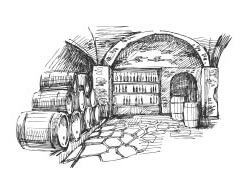The shape of wine


THE HARVEST
We decide the beginning of the harvest by performing an analysis on the bunches, the right degree of sugar and acidity kick off the party!!! We harvest by hand, selecting the best bunches that are put in small boxes making sure not to cause the rupture of the grapes, thus avoiding the beginning of unwanted fermentations.
THE PRESSING
The grapes, harvested in this way, are taken to the wine cellar and processed immediately. We remove the stems through a crusher-destemmer and we bring the grape juice inside refrigerated steel tanks.


THE FERMENTATION
We leave the skins in contact with the must for a few days, until, by tasting the product and looking at it, it has reached the colour and the structure we want. thus begins the first fermentation that will transform the sugar present into the must into alcohol. This phase can last up to 30 days.
THE DECANTING
During all winter months the wine is kept under control by carrying out analyses and tasting the product repeatedly. There are several decanting from one tank to another to ensure that the wine clarifies naturally. We do not use filters.


THE BOTTLING
After 6 months inside the steel tanks, the still wine is ready to be bottled: we bottle everything by hand, getting help only from a small filling machine. We bottle only when the moon allows it because we are dealing with a live product! This year’s total production was of only 9000 bottles!!
THE SECOND FERMENTATION IN THE BOTTLE
The bottles, closed with crown caps, are left to rest for months. Here begins the second fermentation where, the residual sugar inside each bottle, will be transformed into alcohol and carbon dioxide (CO2), forming the famous bubbles!!


THE AGING ON THE YEAST
Spending month in contact with the lees, our Lambrusco refines, softens and is rounded, creating a wine that is one of a kind
THE DISGORGMENT
Before placing the wine on the market, we remove the bottom by placing the bottles on the wooden pupitre; we carry out the remuage to bring the lees in the cap (at the tip). Each bottle is finally reopened, the liqueur de expedicion is added and then the bottle is capped again with a cork and a cage. It is only at this point, at the end of the process, that we will affix our label.


